Problemas de identificación de grandes águilas; variante Barthelemyi del águila real
Text in English bellow
La identificación de plumajes adultos de grandes águilas en principio no representa un problema para realizar una correcta identificación; sin embargo consultar una guía de identificación incompleta puede influir para cometer un error. El águila real es la especie de su genero con mayor rango de distribución y la variante de su plumaje denominada Barthelemyi no esta incluida en la mayoría de guías de aves de Europa y en este continente esto puede provocar errores de identificación con dos especie que solapa su rango de distribución, el águila imperial oriental y el águila imperial ibérica.
Son mas frecuentes de lo que se creen, los problemas o errores de identificación entre adultos de águila real (Aquila chrysaetos) y águila imperial ibérica (Aquila adalberti) en la peninsula ibérica. Inicialmente los plumajes adultos de ambas especies están bien descritos y no deberían de plantear problemas en su identificación. Aunque el color de plumaje de contorno en ambas especies es de color pardo oscuro, si bien en ambas especies puede variar en el tono, el águila real carece de las típicas manchas que tiene el águila imperial ibérica, en las pequeñas coberteras del borde del ala y en las escapulares, estas plumas por lo general son blancas en el águila imperial ibérica.
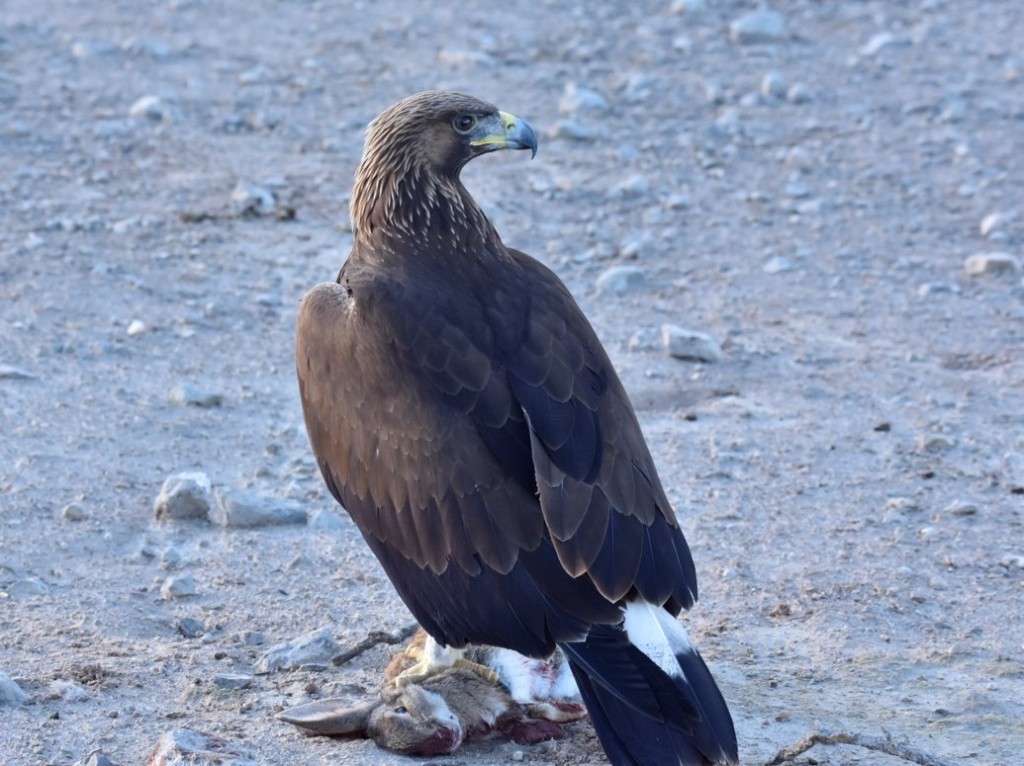
Photography: Robert Penella Pampalona 2020 ©
La mayoría de guías de aves rapaces de Europa, la definición de un ejemplare adulto de águila real es “se ve en gran parte oscura a distancia, con una mancha más pálida en la diagonal en las suprecoberteras alares, la nuca y el cuello dorados en contraste con la cara más oscura. La punta interna de la cola grisácea con bandas oscuras variables y con una anchan banda subterminal negra. Las primarias y secundarias son grises, tanto por encima como por debajo, con un franjeado irregular más oscuro y las puntas ampliamente oscuras. Las aves norteñas son notablemente pálidas y decoloradas por encima y muchas de ellas muestran brillantes lista anaranjadas – rojizas en el pecho y en las infracobertoras alares pequeñas. Las aves de las montañas del centro y sur de Europa son más oscuras, siendo más uniformes por encima y sin la extensa coloración rojiza por debajo” texto extraído de (Forsman, 2016), en otras guías de reciente edición (Ollé & Trabalon 2019), la descripción de las aves adultas es similar a la que realiza Forsman.
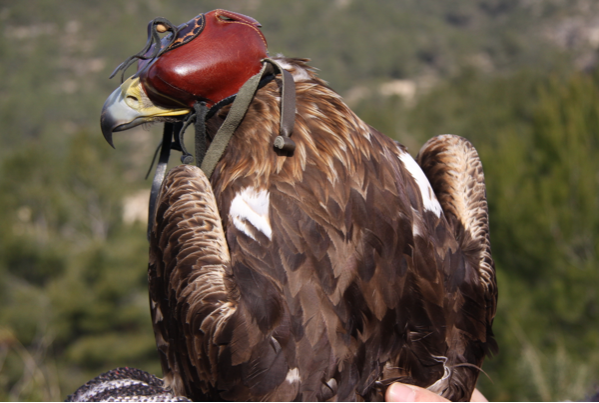
Golden Eagle with subadult plumage and Barthelemyi variant captured in Tarragona Spain
Potography: Victor García Matarranz 2010 ©
Sin embargo y ocasionalmente algunos individuos de águila real presenta una variedad de plumaje que se denomina variante Barthelemyi (Katzner, 2020), esta variedad esta ampliamente descrita guías y en bibliografía de Rapaces de Norteamérica (Clark & Wheeler 1987; Palmer 1988; Johnsgard 1990; Wheeler 2018). Esta variedad se distingue del plumaje clásico, por tener plumas escapulares blancas, similares a las de Aquila Heliaca y Aquila adalberti. Este rasgo aunque se considera poco común, esta muy extendido por Norteamérica (Palmer 1988). Hay observaciones de aves con este plumaje en Colorado, en Minnesota, en California y en los Apalaches, según estas referencias parece posible observar individuos con este plumaje en toda la región. En Europa se ha descrito en los alpes franceses (Besson 1969). En España en distintas regiones se tienen registros de individuos con la variante Barthelemyi, en la provincia de Toledo se han observado 4 ejemplares con plumaje de esta variante en distintas parejas reproductoras, en la Provincia de Salamanca, al noroeste se observo una pareja de águila real en la que el macho con plumaje adulto tenia esta variante en su plumaje, mientras que la hembra tenia plumaje convencional y en Tarragona se capturo para su radiomarcaje un individuo con plumaje subadulto con de la variante Barthelemyi (Matarranz com.per). Por la disparidad de observaciones parece que aunque estos individuos son raros se podrían observar por toda la península ibérica.
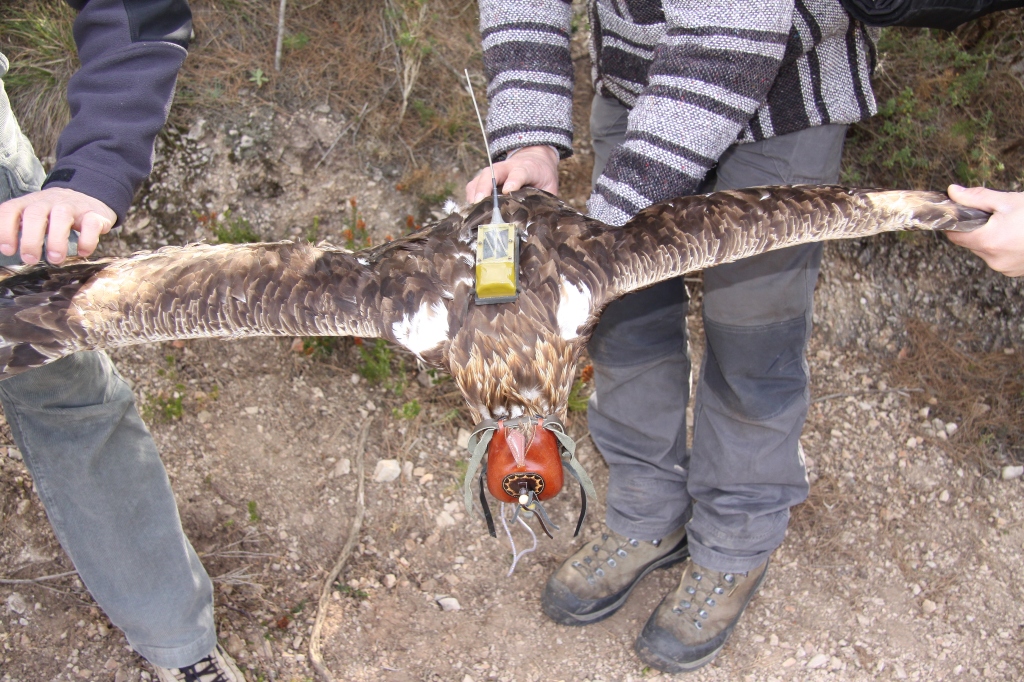
Detail of the scapulars of the golden eagle captured in Tarragona
Photography: Victor García Matarranz 2010 ©
La variante Barthelemyi, ha sido descrito al menos en tres subespecies del Águila real, en Aquila chrysaetos chrysaetos, Aquila chrysaetos canadensis y en Aquila chrysaetos homeyeri. Está característica del plumaje no es típica de una subespecie o de una región, sin embargo no esta descrita en todas las subespecies, posiblemente alguna de las subespecies asiáticas, también puedan tener esta características. Se cree que este rasgo del plumaje puede ser hereditaria, en Estados Unidos en los Apalaches, Spofford (1961) localizo una pareja reproductora formado por dos adultos de la variante Barthelemyi que tuvieron polluelos también con este plumaje. Inicialmente esto denota que es una característica que permanece con la edad. En Cautividad, en el Centro de Estudios de las Rapaces Ibéricas (CERI) en la provincia de Toledo tenia en cautividad un ejemplar macho con la variante Barthelemyi y comprobaron que esta característica era permanente y no variaba con la muda (Blanco com. pers).
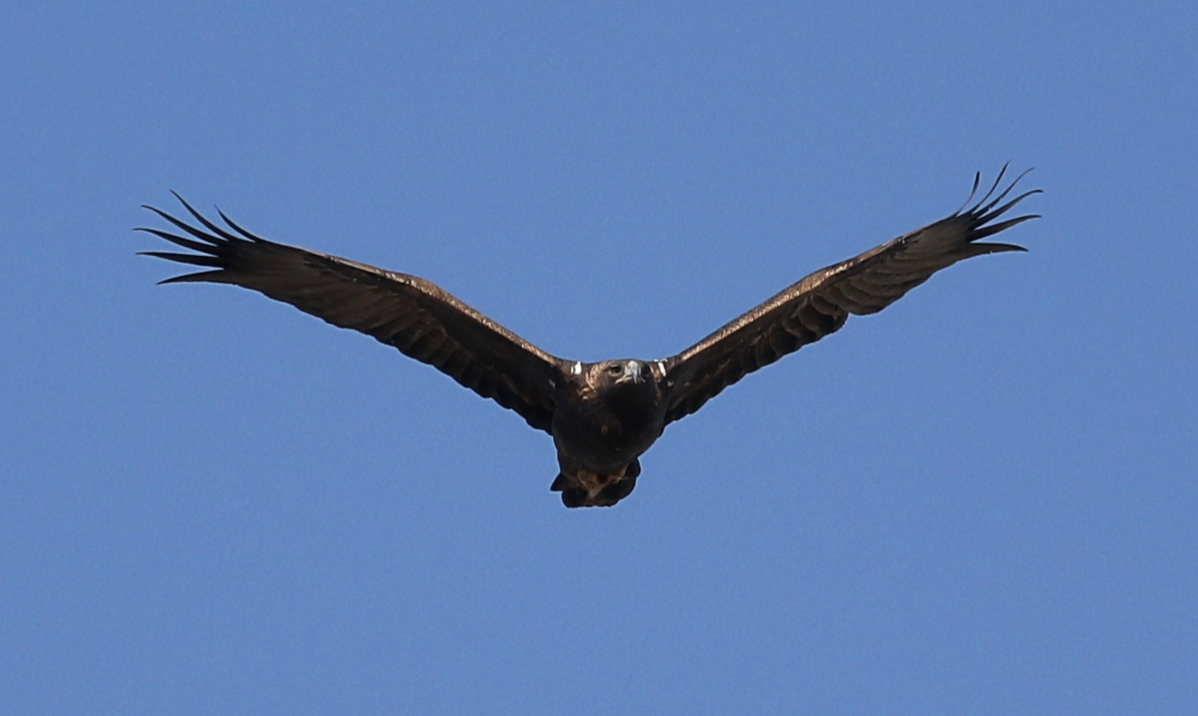
Águila real con la variante Barthelemyi en vuelo frontal con las pequeñas coberteras del borde alar más claras de lo normal. Golden Eagle with Barthelemyi variant in forward flight with small wing-edge coverts lighter than normal.
En España los individuos de la variante Barthelemyi a menudo generan errores de identificación, esta característica del plumaje unida a que el águila real tiene las pequeñas coberteras del borde del ala de color cremoso mas o menos oscuras y por el efecto del desgaste en algunos individuos parecen casi blancas. Cuando estas dos características se unen los errores de identificación son posibles, esto ocurrió por ejemplo con el macho adulto observado en Salamanca, la hembra era de plumaje clásico, sin embargo la pareja se considero como una pareja de águila imperial formada por un adulto y un subadulto, ya que la hembra carecía de manchas blancas. Este error ha podido producirse en otras zonas, por ejemplo en la década de los 80 y 90 había citas de adultos de águila imperial lejos de las localidades donde se reproducía como en la provincia de Burgos, o incluso en zonas donde no existan referencias históricas como en la Provincia de Teruel, estas zonas fueron visitadas y no se observaron ejemplares reproductores de Águila imperial ibérica por lo que podrían ser individuos de águila real de la variante Barthelemyi. Al igual que sucede esta variante con el plumaje del águila real ocurre algo similar con el águila imperial ibérica y con el águila imperial oriental, se han descrito ejemplares adultos que carecen de las típicas manchas de las cobertoras, escapulares o ambas el el caso de Aquila adalberti o de escapulares blancas en el caso de Aquila Heliaca. Algo similar le ocurre al Águila imperial oriental con las pequeñas cobertoras alares, normalmente en esta especie son de color pardo cremoso, similar al águila real, sin embargo existen ejemplares con pequeños parches de plumas blancas, muy similares a Aquila adalberti, aunque no se conocen individuos con las grandes manchas típicas de esa especie.
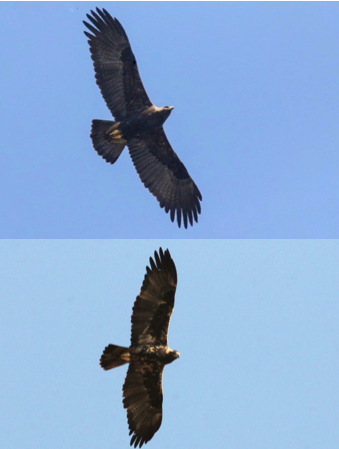
Detail of the caudal undertail feathers, Heliaca above and adalberti below
Photography: Roberto Sánchez 2004-2014 ©
Las tres especies de águila, están incluidas en el mismo genero, y aunque pueden tener ciertas características en el diseño de plumajes identificativas de cada especie. Se ha comprobado que las tres especies pueden tener características de diseño de las otras especies, sin embargo las diferencias son claras en los diseños de las plumas de vuelo, en Aquila adalberti y heliaca son similares pero Aquila chrysaetos presenta diferentes patrones en el barreado de las plumas del ala y de la cola. Ademas las siluetas de vuelo de las Águilas imperiales son diferentes a la del águila real, esto es sin duda el principal rasgo de identificación cuando se observen ejemplares de águila real de la variante Barthelemyi o águilas imperiales sin los parches de plumas blancas. Otra característica inconfundible es el reclamo, el águila real independientemente de la variante de plumaje, su reclamo es un silbido y las águila imperiales su reclamo es un ladrido. En el caso de los adultos del águila imperial, hasta la década de los 90 Aquila adalberti y heliaca estaban totalmente aisladas, sin embargo desde el año 2000 se han registrado varias observaciones de juveniles de águila imperial oriental en la Península Ibérica, hasta ahora no se ha realizado ninguna observación de adultos, pero por su carácter migratorio si están llegando individuos juveniles podría hacerlo algún individuo adulto. Una característica de identificación de los individuos adultos de ambas especies son las infracobertoras caudales, en Aquila adalberti son pardo negruzcas mientras que en Áquila heliaca son pardo amarillentas, esta característica es más determinante que las típicas manchas blancas ya que especialmente en Aquila adalberti son variables y se han descrito varios patrones (Bortolotti et al. 2008), otro rasgo identificativo puede ser el color del iris, para el águila imperial ibérica se han descrito diferentes tonos de color marrón, sin embargo el águila imperial oriental presenta una gama más amplia de colores desde amarillo hasta color marrón oscuro.
No hay referencias de errores de identificación de águila real de la variante Barthelemyi con águilas imperiales orientales, pero esta posibilidad debería de tenerse en cuenta en regiones donde cualquiera de estas dos especies sean raras o no estén presentes.
Citar como / Cite as: Sánchez, R. 2021. Problemas de identificación de grandes águilas; variante Barthelemyi del águila real. Eagle News, Ecología y Conservación de las Rapaces entrada 64. Great Eagles Identification Problems; Barthelemyi variant of the golden eagle. Eagle News, Ecology and Conservation of Raptors post 63.
Great Eagles Identification Problems; Barthelemyi variant of the golden eagle
In principle, the identification of adult plumage of great eagles does not represent a problem to carry out a correct identification; however consulting an incomplete identification guide may influence you to make a mistake. The Golden Eagle is the species of its genus with the greatest distribution range and the variant of its plumage called Barthelemyi is not included in most bird guides in Europe and on this continent this can cause identification errors with two species that overlap their range, the Eastern Eagle and the Spanish Imperial Eagle.
Identification problems or errors between adults of the Golden Eagle (Aquila chrysaetos) and the Spanish Imperial Eagle (Aquila adalberti) are more frequent than is believed in the Iberian Peninsula. Initially the adult plumages of both species are well described and should not pose problems in their identification. Although the color of the outline plumage in both species is dark brown, although in both species it may vary in tone, the golden eagle lacks the typical spots that the Spanish Imperial Eagle has, in the small coverts of the edge of the wing and on the scapulars, these feathers are generally white in the Spanish Imperial Eagle.
In most European raptor guides, the definition of an adult golden eagle is “seen largely dark at a distance, with a paler spot diagonally on the upper wing coverts, nape and neck gold on contrast with the darker face. The inner tip of the tail greyish with variable dark bands and a wide black subterminal band. The primaries and secondaries are gray, both above and below, with darker irregular stripes and widely dark tips. Northern birds are remarkably pale and discolored above, and many of them display bright orange-reddish stripes on the chest and on the small undercovers. The birds of the mountains of central and southern Europe are darker, being more uniform above and without the extensive reddish coloration below «text extracted from (Forsman, 2016), in other recently edited guides (Ollé & Trabalon 2019) , the description of adult birds is similar to that given by Forsman.
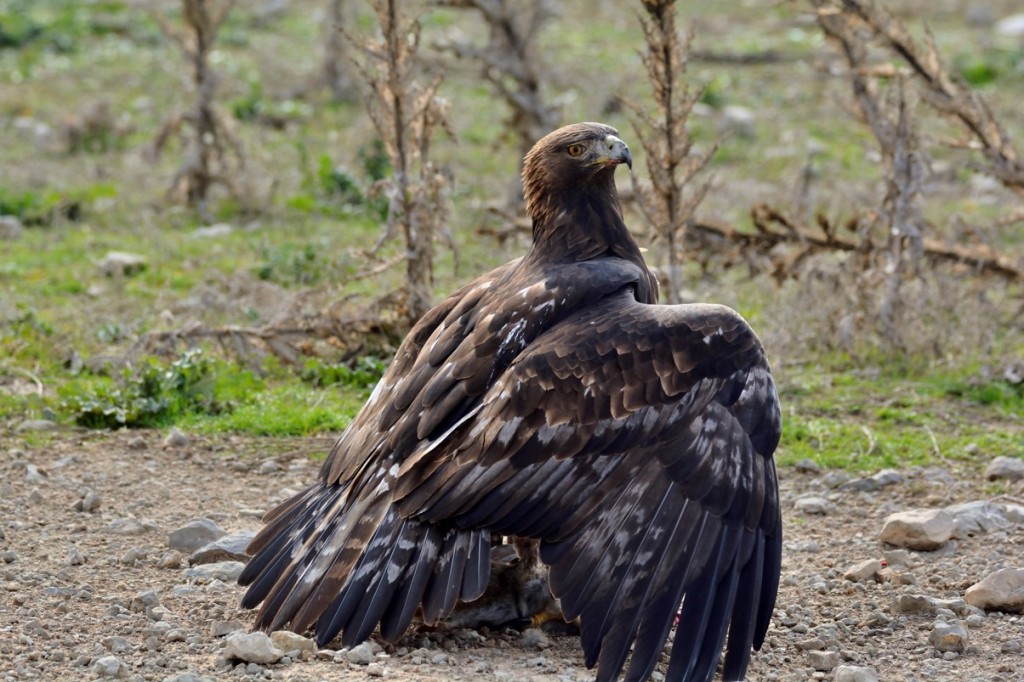
Aquila chrysaetos homeyeri with typical adult plumage, however medium bicolor scapular feathers can be seen (white base and blackish-brown tips)
Photography: Robert Penella Pampalona 2020 ©
However, occasionally some individuals of the golden eagle present a variety of plumage that is called Barthelemyi variant (Katzner, 2020), this variety is widely described in guides and in the Raptors of North America bibliography (Clark & Wheeler 1987; Palmer 1988; Johnsgard 1990; Wheeler 2018). This variety is distinguished from the classic plumage, by having white scapular feathers, similar to those of Aquila Heliaca and Aquila adalberti. This trait, although considered uncommon, is widespread in North America (Palmer 1988). There are observations of birds with this plumage in Colorado, Minnesota, California and the Appalachians, based on these references it seems possible to observe individuals with this plumage throughout the region. In Europe it has been described in the French Alps (Besson 1969). In Spain in different regions there are records of individuals with the Barthelemyi variant, in the province of Toledo 4 specimens with plumage of this variant have been observed in different breeding pairs, in the Province of Salamanca, to the northwest a pair of golden eagles was observed in which the male with adult plumage had this variant in its plumage, while the female had conventional plumage and in Tarragona an individual with subadult plumage with the Barthelemyi variant (Matarranz com.per) was captured for radio tagging. Due to the disparity of observations, it seems that although these individuals are rare, they could be observed throughout the Iberian Peninsula.
The Barthelemyi variant has been described in at least three subspecies of the Golden Eagle, in Aquila chrysaetos chrysaetos, Aquila chrysaetos canadensis and in Aquila chrysaetos homeyeri. This characteristic of the plumage is not typical of a subspecies or a region, however it is not described in all subspecies, possibly some of the Asian subspecies, they may also have these characteristics. It is believed that this plumage trait may be hereditary, in the United States in the Appalachians, Spofford (1961) located a breeding pair formed by two adults of the Barthelemyi variant that also had chicks with this plumage. Initially this denotes that it is a characteristic that remains with age. In Captivity, at the Iberian Raptor Studies Center (CERI) in the province of Toledo, they had a male specimen with the Barthelemyi variant in captivity and they verified that this characteristic was permanent and did not vary with the molt (Blanco pers. Comm.).
In Spain, individuals of the Barthelemyi variant often generate identification errors, this characteristic of the plumage together with the fact that the golden eagle has the small coverts of the edge of the wing of creamy color more or less dark and due to the effect of wear in some individuals they seem almost white. When these two characteristics are combined, identification errors are possible, this happened for example with the adult male observed in Salamanca, the female was of classic plumage, however the pair was considered as a pair of imperial eagle formed by an adult and a subadult, since the female lacked white spots. This error could have occurred in other areas, for example in the 80s and 90s there were adult imperial eagle citations far from the localities where it was reproduced, such as in the province of Burgos, or even in areas where there are no historical references such as In the Province of Teruel, these areas were visited and no reproductive specimens of the Spanish Imperial Eagle were observed, so they could be individuals of the Barthelemyi variant of the golden eagle. As this variant happens with the plumage of the golden eagle, something similar happens with the Spanish Imperial Eagle and the Eastern Eagle, adult specimens have been described that lack the typical spots of the coverts, scapulars or both in the case of Aquila adalberti or white scapulars in the case of Aquila Heliaca. Something similar happens to the Eastern Imperial Eagle with the small wing coverts, normally in this species they are creamy brown in color, similar to the golden eagle, however there are specimens with small patches of white feathers, very similar to Aquila adalberti, although they are not known. individuals with the large spots typical of that species.
The three species of eagle are included in the same genus, and although they may have certain characteristics in the design of identifying plumage of each species. It has been verified that the three species may have design characteristics of the other species, however the differences are clear in the designs of the flight feathers, in Aquila adalberti and heliaca they are similar but Aquila chrysaetos present different patterns in the barred of the wing and tail feathers. In addition, the flight silhouettes of the Imperial Eagles are different from that of the golden eagle, this is undoubtedly the main identifying feature when observing specimens of the golden eagle of the Barthelemyi variant or imperial eagles without the patches of white feathers. Another unmistakable feature is the call, the golden eagle regardless of the variant of plumage, its call is a hiss and the imperial eagles their call is a bark. In the case of the adults of the imperial eagle, until the 90s Aquila adalberti and heliaca were totally isolated, however, since 2000, several observations of juveniles of the Eastern Imperial eagle have been registered in the Iberian Peninsula. It has made no observation of adults, but due to its migratory nature, if juvenile individuals are arriving, an adult individual could do so. An identification characteristic of the adult individuals of both species are the caudal undertail coverts, in Aquila adalberti they are blackish brown while in Aquila heliaca they are yellowish brown, this characteristic is more decisive than the typical white spots since especially in Aquila adalberti they are variable and Several patterns have been described (Bortolotti et al. 2008), another identifying feature may be the color of the iris, for the Iberian imperial eagle different shades of brown have been described, however the eastern imperial eagle has a wider range of colors from yellow to dark brown.
There are no references of golden eagle misidentification of the Barthelemyi variant with eastern imperial eagles, but this possibility should be considered in regions where either of these two species are rare or not present.
Bibliografia / Refrences
Besson, J. (1969). Un Aigle royal Aquila chrysaetos de la variante Barthelemyi dans les Basses Alpes. Alauda 37: 258–260.
Bortolotti, G. R., González, L. M., Margalida, A., Sánchez, R., & Oria, J. (2008). Positive assortative pairing by plumage colour in Spanish imperial eagles. Behavioural processes, 78(1), 100-107.
Clark, W. S., and B. K. Wheeler (1987). A Field Guide to Hawks of North America. Houghton Mifflin Company, Boston, MA, USA.
Forsman D. (2016) Identificación en vuelo, aves rapaces de Europa, África del norte y Oriente Medio. Editorial Omega, ISBN 978-84-282-1644-9.
Johnsgard, P. A. (1990). Hawks, Eagles and Falcons of North America: Biology and Natural History. Smithsonian Institution Press, Washington, DC, USA.
Katzner, T. E., M. N. Kochert, K. Steenhof, C. L. McIntyre, E. H. Craig, and T. A. Miller (2020). Golden Eagle (Aquila chrysaetos), version 2.0. In Birds of the World (P. G. Rodewald and B. K. Keeney, Editors). Cornell Lab of Ornithology, Ithaca, NY, USA. https://doi.org/10.2173/bow.goleag.02
Palmer, R. S., Editor (1988). Diurnal raptors. In Handbook of North American Birds. Yale University Press, New Haven, CT, USA. pp. 324–380.
Spofford, W. R. (1961). White epaulettes in some Appalachian Golden Eagles. Prothonotary 27: 99.
Wheeler, B. K. (2018). Birds of Prey of the West, A Field Guide. Princeton University Press, Princeotn, NJ, USA.



One individual with this plumage also photogaphed in the central french Pyrenees in 2019
Me gustaLe gusta a 1 persona
Adam, thank you very much for your comment. It seems that this plumage is more common than it seems. I’m surprised that it doesn’t come described in the bird guides of Europe
Me gustaMe gusta